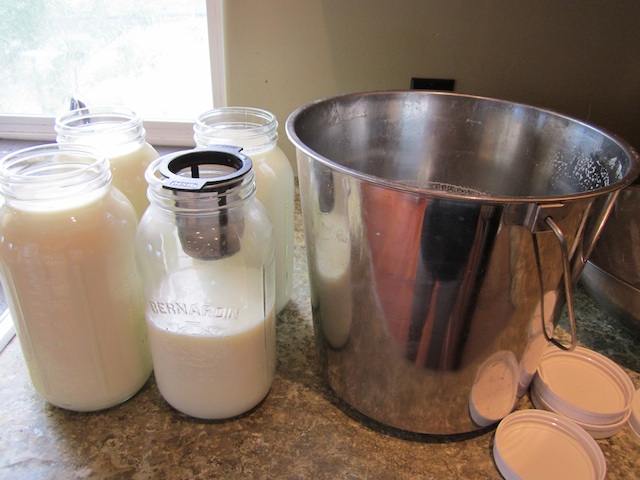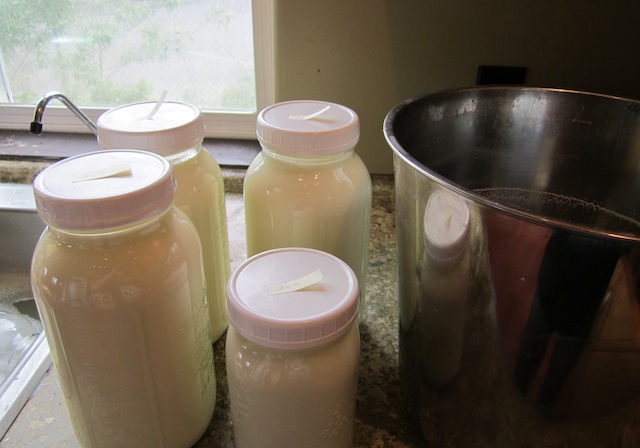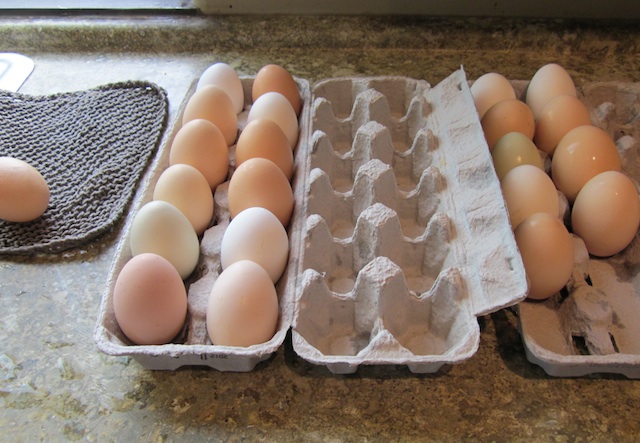
I have just removed the lid from the milking pail. Shaen was working in the pasture and the milk pail was chilled before I got it. I have organized the 2L mason jars. You can see the metal coffee filter that we use for filtering milk.
I have had a number of people ask me how we process milk and eggs at home. Most of the specialized equipment we use would be found in a traditional household. These items include glass mason jars, plastic lids, stainless steel pails, stainless steel milk pail lid, coffee filter and recycled egg cartons.
We do not use any industrial equipment such as milking machines, commercial dishwashers, separators or filtering machines. We use a metal coffee filter for filtering the milk. We wash up the equipment in our kitchen sink and process farm products on the kitchen counter. I hope these pictures will help describe the process better than an essay on the topic.

I have filtered the milk using the metal coffee filter by carefully pouring from the pail into the mason jars. I have only 7L of milk so I will transfer the milk into a 1L mason jar.
Shaen milks our cow by hand into a stainless steel pail. After milking Shaen covers the milk with a lid, to avoid stuff dropping into the milk. If Shaen has to work in the pasture after milking, he will quick-chill the milk pail by using running well water in a bucket large enough to take the milk pail. When Shaen returns with the milk I will take the milk pail and process the milk on the kitchen counter.
I organize the needed number of clean and dry 2L and 1L mason jars. I have a small metal coffee filter that sits on the top of the mason jar. I carefully pour the milk though the filter into each mason jar. I then screw on a plastic lid. I prefer plastic lids because they are easier to clean; I keep my canning lids for canning. I then date the top of each milk jar. The milk is quickly transferred to a fridge for cooling. I wash the pail and coffee filter in the kitchen sink. I let both air dry in the dish rack.

I prefer the plastic lids because they are easier to clean. I feel comfortable with plastic lids because the plastic in not in contact with the milk. I have dated the milk and will immediately transfer the milk to the fridge.
After I finish the milk, I start on the eggs. Shaen keeps all the eggs from the day before up in the pasture shed so I only have have to clean eggs once a day. If the eggs are really clean I will not wash them. Normally, I have to wash the eggs.
I put them in some warm, soapy water in the kitchen sink. I carefully wash away any grime. I rinse each egg under a stream of clean water. I set the washed eggs into the lid of the egg carton to dry. Any rejected eggs go to feed the hogs or I will break them into a bowl for breakfast.
After the eggs dry, I set them in the egg carton with the pointy end down. It is reported to make the eggs last longer. I carefully wash out my kitchen sink and make breakfast. So far we have not gotten sick from cleaning barnyard products in our kitchen.

These are eggs drying in the lid of the egg carton. The rejected eggs will be used for this morning's breakfast.

